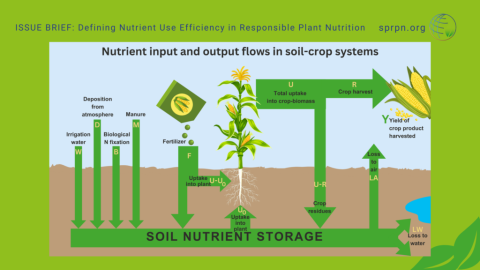We’re facing the increasing global challenge of ensuring food security while protecting the environment. As a promising strategy, responsible plant nutrition has emerged, which centres around the concept of nutrient use efficiency. This multifaceted indicator seems to hold the key to sustainable agricultural systems. In this Issue Brief, we delve into the central role of nutrient use efficiency in achieving the five aims of responsible plant nutrition and we present the major indicators to use for different purposes.
Nutrient use efficiency has emerged as a foundation of sustainable agricultural practices, serving as a crucial indicator for sustainability assessments in farming. Since discussions on sustainability frequently emphasize resource use efficiency, nutrient use efficiency offers a nuanced perspective on nutrient inputs and outputs in relation to responsible plant nutrition.
The Variability Of Nutrient Use Efficiency
At its core, nutrient use efficiency refers to the ratio of nutrient outputs to inputs within an agricultural cropping system. This ratio assesses how effectively a system uses the available nutrients as an input to produce crops as its major output.
In that sense, a high output/input ratio indicates a minimal amount of waste. This translates to low production costs, reduced environmental losses, and decreased depletion of non-renewable resources. In essence, nutrient use efficiency aligns with the broader goals of securing global food availability while protecting the environment.
However, the complexity lies in the variability of agricultural systems. The inputs and outputs considered, the spatial and temporal scales, and the boundaries of the system can all vary widely.
For instance, nutrient inputs encompass different sources such as fertilizers, manure, irrigation water, biological nitrogen fixation, and even deposition from the air. Likewise, outputs might involve harvested crop products, above-ground biomass, and nutrient uptake from added fertilizers.
Based on this diversity, many different formulas have been proposed to calculate nutrient use efficiency.
The Need For A Comprehensive Approach
To address this complexity, we propose to use those indicators that align nutrient use efficiency with the goals of responsible plant nutrition. These indicators fall into three categories: fertilizer indicators, crop indicators, and system indicators.
- Fertilizer Indicators
These indicators, such as partial factor productivity, agronomic efficiency, and recovery efficiency, focus on the efficiency of nutrient utilization originating from fertilizers. They define how effectively applied nutrients are translated into crop yield, providing insights into the economic and agronomic efficiency of nutrient use.
- Crop Indicators
Crop indicators define the allocation of nutrients within a plant and its impact on crop yield and crop quality. Metrics like internal efficiency, physiological efficiency, nutrient harvest index, and nutrient concentration represent the plant’s ability to transform acquired nutrients into economic yield.
- System Indicators
System indicators take a more comprehensive approach, considering nutrient balance ratios at various scales. Nutrient use efficiency expressed as a partial nutrient balance ratio is particularly insightful for soil surface nutrient balances. On a broader scale, the farm-gate nutrient balance ratio takes into account the complete farming system by integrating diverse inputs and outputs.
Linking Nutrient Use Efficiency To The Five Aims Of Responsible Plant Nutrition
Responsible plant nutrition encompasses a holistic perspective that spans economic, environmental, and health considerations. Nutrient use efficiency, as a versatile indicator, can be aligned with these aims:
- Improving Income and Efficiency: Several indicators provide valuable insights into the economic efficiency of nutrient use, guiding decisions to optimize yield and resource allocation.
- Nutrient Recovery and Recycling: Some metrics highlight how efficiently nutrients are routed between harvested portions and crop residues, facilitating better nutrient management practices.
- Sustaining Soil Health: Some indicators underscore the intricate relationship between nutrient use and soil health, paving the way for sustainable agricultural systems.
- Enhancing Human Health: The nutrient concentration within harvested crop products directly impacts their nutritional value, supporting efforts to produce nutrient-rich foods.
- Minimizing Nutrient Pollution: By minimizing nutrient losses through enhanced efficiency, nutrient use efficiency aligns with the imperative to reduce nutrient pollution in its various forms.
Towards A Sustainable Future
While nutrient use efficiency offers invaluable insights, it is crucial to view it in relationship with other indicators to make informed decisions. The nexus of productivity, soil health, and environmental considerations must be analyzed together for a comprehensive assessment. By focusing on nutrient use efficiency targets together with productivity and environmental goals, holistic responsible plant nutrition can be achieved.
As the global population continues to grow, and the pressure on both food production and our environment intensifies, responsible plant nutrition becomes non-negotiable. Embracing and refining indicators for nutrient use efficiency provides a practical toolkit to not only enhance crop yields but also minimize environmental degradation.
With this Issue Brief, we aim to empower farmers, policymakers, and businesses with actionable insights. Together, we can pave the way for a more sustainable future that balances the needs of our population with the health of our planet.


